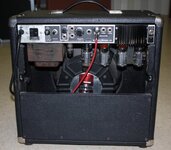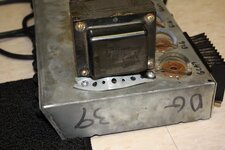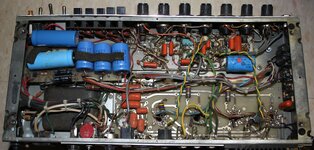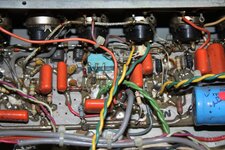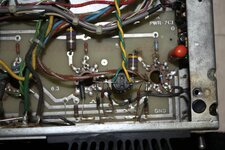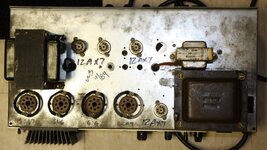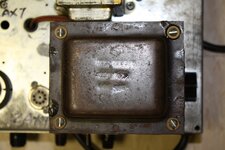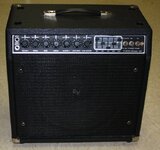GJgo
Well-known member
Over on Facebook on the IIC+ page, a member named Dann Valentino did an IN-DEPTH technical breakdown of the IIC+ reissue. He's not a member here (yet), but with his permission I wanted to post what he had to say over here as there's some good info. Here you go!! There's also quite a few good Q&As in the comments on the FB thread.
WARNING - Long and somewhat technical post.
Going off from Tony Batal's pics (thank you for posting these, mate!!) I will write what I see in a rather long post. Feel free to skip, correct me or disagree with me - I am just rambling nerd stuff. Those are purely technical observations and are not intended to put down the amp or how it sounds - if you like it - you like it and that's that. I'm only sharing thoughts on purely technical details - some people like to obsess over their "MoP settings, maaan", I like to obsess over technical details as an engineer and a designer. Some of the points I am including in this post can be considered as servicing cautions and what to expect/look for, others as general info.
Transformers:
Woodward-Schumacher Electric Transformers. GOOD! They went back to the original manufacturer. Makes me wonder what was the real reason (not the PR reason) for the short period not using Schumacher.
EIA606MS stands for "Electronic Industries Alliance". 606 is the manufacturer code for Schumacher, MS should be internal marking for Mesa. The 4 numbers after that are the date. In Tony's particular amp: the power transformer - 29th week of 2024, the output transformer - 35th week of 2023. That tells me that they are using their available stock of 542004 OTs and 561860 PTs. That version of the 562004 has been used in Mark V90, VII. The 561860 is used in the JP2C and in the Mark VII.
Interesting that they used the 562004 transformer and didn't order an earlier spec for the RI. The last transformer that is 1:1 to the original Simul-Class design is the 562003 (they just went to a new naming scheme). The 562004 they changed to a smaller lamination stack which did not change the tone that much in my tests(not pushing to full core saturation, tested with normal usage in mind). In the 562004R-1 (later Mark III Green Stripes, Mark IV Bs, later 2:90s) they removed two of the additional windings that define the original SimulClass transformer and that change definitely yielded a different character and impedance curves in my tests.
My main concern here is that I've seen a lot of later black chassis Mark IV Bs for instance, with the 562004 stamped on them, and after a few simple measurements it turns out it's technically a 562004R-1. I don't know why they did that tbh and not just keep using the 562004R-1 with it's proper name. After all they are two different designs. I actually haven't checked what's up in later models (Mark V, Mark VII) that also use the 562004 stamp on the transformers, but this raised my curiosity. Tony - could you test with a ohm meter to determine if the OTs on the RI and VII are true SimulClass like the previous 562003/562004 or it's technically a 562004R-1? No high voltage, no danger. I will shoot you a PM how to test it if you are down.
For more context - here's a real-world test between 562003, 562004 and 562004R-1 in the same amp.
Overall layout:
The original design is not too crowded or hard to follow, so personally I don't see the need to stack the preamp tubes like they did in the RI. There is enough space. If I would've changed the OG layout - probably put more space between a few know-to-act-up components, but keep the overall topology similar. As some of you know - component proximity/EMF/inductance is a thing and parts can influence each other easily. Even Randall Smith mentioned it the other day on his new YT series. I admit - this is cork-sniffing 101, probably less than 5% of differences if you will, but shouldn't a reissue be as close as possible to the original? I am now 100% sure the layout and/or lead dress are the causes of the reported oscillations. Strangely enough - the original amps (if taken care of and in 100% working condition), even though they can be considered a hot mess by most techs - don't have those problems. This fact and a video that I posted a few weeks ago proves that component placement/lead dress/layout can be a big part of how an amp behaves and to a degree - how it sounds.
Some stuff technically cannot be the same as in the OG (RoHS/CE compliance, availability ect), I've spoken about that even before the release, but the component layout is at the PCB designer's discretion and he can do whatever he wants (given it covers some basic rules and requirements). So the question for me is why not stick with the original, proven PCB layout that has millions of miles on it and just tweak from there. I think they could've spent a bit more time on the layout and this whole topic wouldn't be a thing - and frankly it's probably costing them a bit of revenue now.
They don't make the in-house PCBs like they did in the 70s and 80s. The old method actually required a lot more labor and time to make (manual drawing, masking, etching, drilling, tinning ect). After all, almost every PCB nowadays is manufactured with more automated methods, mostly in large, PCB printing facilities, most of them oversees, so manufacturing and prototyping today is ultra cheap and very fast - narrowing down the design for my SP2C V2++ boards cost me ~80EURO + shipping for two sets of prototype boards, arriving in 2-3 workdays. So for their level of operation and in-house capabilities, spending a few more days 100% nailing it - a no-brainer to me.
EDIT: By that I meant that they can very easily and cheaply make a few prototypes and nail down the layout and only then start producing the final boards with no "re-tooling" needed for every iteration. contrary to how it used to be.
The tube layout is reminiscent of what they have been doing since the Mark V (especially with the 25 and 35 variants).
TBH, I don't see a single big issue with the preamp board, but rather a few small things that don't make much sense to me. Especially when copying a simpler design like the IIC+. One being the stacked preamp tubes, second would be putting the power supply/GEQ/preamp on one board, another - the weird criss-cross jumper cables for the heater filament supply. From my own experience designing PCBs - as soon as you run out of ways to use the two layers on a PCB and start jumpering with wires - you've put yourself in a corner and better go back and rethink some things. I'll give that kind of a pass though, since that there is a jumper cable in the original IIC+ as well (although for the Lead Circuit). The OG layout is not "TECHNICALLY" considered great (including the RP-11x boards), but it's been bulletproof for 40 years and as mentioned before - it's layout is somewhat contributing to the sound, so I would've just copied that in a heartbeat. Why open this Pandora's box, having to wait for this design to prove itself or show it's flaws instead of just betting on +40 years proven layout and build from there. For servicing purposes I would've never put the power supply and the whole preamp+GEQ (or in some other cases - the whole amp) on one board. I get why some brands do it (especially if led by non-tech minded suits) - micromanaging every cent spent, but I just wish they would've considered the guys like me that at some point will have to repair or work on those amps, hahah. In the attached pics I will include one of a Mark V:25 that required a PT change and the technician that worked on it needed to gut the whole amp to pull out the transformer. That's not good engineering.
(Continued in comments)
WARNING - Long and somewhat technical post.
Going off from Tony Batal's pics (thank you for posting these, mate!!) I will write what I see in a rather long post. Feel free to skip, correct me or disagree with me - I am just rambling nerd stuff. Those are purely technical observations and are not intended to put down the amp or how it sounds - if you like it - you like it and that's that. I'm only sharing thoughts on purely technical details - some people like to obsess over their "MoP settings, maaan", I like to obsess over technical details as an engineer and a designer. Some of the points I am including in this post can be considered as servicing cautions and what to expect/look for, others as general info.
Transformers:
Woodward-Schumacher Electric Transformers. GOOD! They went back to the original manufacturer. Makes me wonder what was the real reason (not the PR reason) for the short period not using Schumacher.
EIA606MS stands for "Electronic Industries Alliance". 606 is the manufacturer code for Schumacher, MS should be internal marking for Mesa. The 4 numbers after that are the date. In Tony's particular amp: the power transformer - 29th week of 2024, the output transformer - 35th week of 2023. That tells me that they are using their available stock of 542004 OTs and 561860 PTs. That version of the 562004 has been used in Mark V90, VII. The 561860 is used in the JP2C and in the Mark VII.
Interesting that they used the 562004 transformer and didn't order an earlier spec for the RI. The last transformer that is 1:1 to the original Simul-Class design is the 562003 (they just went to a new naming scheme). The 562004 they changed to a smaller lamination stack which did not change the tone that much in my tests(not pushing to full core saturation, tested with normal usage in mind). In the 562004R-1 (later Mark III Green Stripes, Mark IV Bs, later 2:90s) they removed two of the additional windings that define the original SimulClass transformer and that change definitely yielded a different character and impedance curves in my tests.
My main concern here is that I've seen a lot of later black chassis Mark IV Bs for instance, with the 562004 stamped on them, and after a few simple measurements it turns out it's technically a 562004R-1. I don't know why they did that tbh and not just keep using the 562004R-1 with it's proper name. After all they are two different designs. I actually haven't checked what's up in later models (Mark V, Mark VII) that also use the 562004 stamp on the transformers, but this raised my curiosity. Tony - could you test with a ohm meter to determine if the OTs on the RI and VII are true SimulClass like the previous 562003/562004 or it's technically a 562004R-1? No high voltage, no danger. I will shoot you a PM how to test it if you are down.
For more context - here's a real-world test between 562003, 562004 and 562004R-1 in the same amp.
Overall layout:
The original design is not too crowded or hard to follow, so personally I don't see the need to stack the preamp tubes like they did in the RI. There is enough space. If I would've changed the OG layout - probably put more space between a few know-to-act-up components, but keep the overall topology similar. As some of you know - component proximity/EMF/inductance is a thing and parts can influence each other easily. Even Randall Smith mentioned it the other day on his new YT series. I admit - this is cork-sniffing 101, probably less than 5% of differences if you will, but shouldn't a reissue be as close as possible to the original? I am now 100% sure the layout and/or lead dress are the causes of the reported oscillations. Strangely enough - the original amps (if taken care of and in 100% working condition), even though they can be considered a hot mess by most techs - don't have those problems. This fact and a video that I posted a few weeks ago proves that component placement/lead dress/layout can be a big part of how an amp behaves and to a degree - how it sounds.
Some stuff technically cannot be the same as in the OG (RoHS/CE compliance, availability ect), I've spoken about that even before the release, but the component layout is at the PCB designer's discretion and he can do whatever he wants (given it covers some basic rules and requirements). So the question for me is why not stick with the original, proven PCB layout that has millions of miles on it and just tweak from there. I think they could've spent a bit more time on the layout and this whole topic wouldn't be a thing - and frankly it's probably costing them a bit of revenue now.
They don't make the in-house PCBs like they did in the 70s and 80s. The old method actually required a lot more labor and time to make (manual drawing, masking, etching, drilling, tinning ect). After all, almost every PCB nowadays is manufactured with more automated methods, mostly in large, PCB printing facilities, most of them oversees, so manufacturing and prototyping today is ultra cheap and very fast - narrowing down the design for my SP2C V2++ boards cost me ~80EURO + shipping for two sets of prototype boards, arriving in 2-3 workdays. So for their level of operation and in-house capabilities, spending a few more days 100% nailing it - a no-brainer to me.
EDIT: By that I meant that they can very easily and cheaply make a few prototypes and nail down the layout and only then start producing the final boards with no "re-tooling" needed for every iteration. contrary to how it used to be.
The tube layout is reminiscent of what they have been doing since the Mark V (especially with the 25 and 35 variants).
TBH, I don't see a single big issue with the preamp board, but rather a few small things that don't make much sense to me. Especially when copying a simpler design like the IIC+. One being the stacked preamp tubes, second would be putting the power supply/GEQ/preamp on one board, another - the weird criss-cross jumper cables for the heater filament supply. From my own experience designing PCBs - as soon as you run out of ways to use the two layers on a PCB and start jumpering with wires - you've put yourself in a corner and better go back and rethink some things. I'll give that kind of a pass though, since that there is a jumper cable in the original IIC+ as well (although for the Lead Circuit). The OG layout is not "TECHNICALLY" considered great (including the RP-11x boards), but it's been bulletproof for 40 years and as mentioned before - it's layout is somewhat contributing to the sound, so I would've just copied that in a heartbeat. Why open this Pandora's box, having to wait for this design to prove itself or show it's flaws instead of just betting on +40 years proven layout and build from there. For servicing purposes I would've never put the power supply and the whole preamp+GEQ (or in some other cases - the whole amp) on one board. I get why some brands do it (especially if led by non-tech minded suits) - micromanaging every cent spent, but I just wish they would've considered the guys like me that at some point will have to repair or work on those amps, hahah. In the attached pics I will include one of a Mark V:25 that required a PT change and the technician that worked on it needed to gut the whole amp to pull out the transformer. That's not good engineering.
(Continued in comments)

